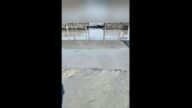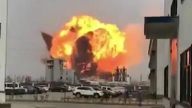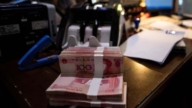【新唐人2012年7月26日讯】内蒙古的包头是中国最大的“稀土”生产基地。尽管“稀土”是珍贵的矿产资源,但是污染危害性却非常大。近期,法国媒体记者发自包头的一篇报导说:“中国稀土杀死村庄”,文章介绍了当地由于生产稀土,大面积污染环境,造成居民、牲畜和土地受到毒害的情况。下面请跟着记者一起去了解。
法国《世界报》的文章说,飞到包头,从天空向下看到一个湖泊,周围许多溪水流入,但走到这个湖泊跟前却发现,这片浑浊的水面是个10平方公里的巨大废水池,周边工厂向这里排放处理17种稀土的废水,水中没有鱼,也看不到水草。
文章中说,离这片废水湖120公里处,是“巴彦敖包稀土矿”,矿里的岩石“稀土”含量并不高,需要用化学酸水进行提取。而处理过“稀土”的废水,含有众多化学有毒物质和放射物质,这些物质会引发胰腺癌,肺癌和血癌。
而现在那里方圆10里,散发着刺鼻的气味。附近村民相继患上癌症,村子里一排排棕色房子都变成了废墟。
四川环保人士陈云飞表示,“稀土”提炼过程,对环境的污染和破坏力极大。而这个项目的具体危害性,是哪些专家的决策,却都没有向老百姓公布。
环保人士 陈云飞:“它有些官员他就是有利可图,他把钱一弄到手,他移民的移民,调的调,他因为有些是形象工程﹔还有一种就是官商勾结,就是官员在里面有股份,他不管老百姓的死活,丢个烂摊子。”
据当地居民介绍,原先包头那里是一望无际的田野。1958年包头钢铁厂开始开采稀土,到了1980年末,居民发现植物出了问题。
据《中国环境报》去年年中的报导指出,包头钢铁集团尾矿库水的渗漏已经对周围5个村子、3000多户农民造成严重影响,两万多亩耕地无法耕种。原“包头市稀土研究院”院长马鹏起表示,由于尾矿坝下面没有防水层,如今尾矿坝的水正以每年300米的速度朝黄河渗透。
另外,居民透露,不但包头钢铁公司开发“稀土”污染环境,之后的各种工厂和火力发电厂,也加重了这个地方的污染。当地居民呼吸着硫酸等化学蒸汽和煤灰。煤灰飘荡在房屋周围,伸出手能够抓着粉尘,肉眼可见手里的煤灰。农民饲养的牛、马、山羊和鸡,都被毒死了。
当地居民纷纷逃离,新光三村的2000村民现在只剩下300人,但家家都有病人。为了污染问题,村民向地方政府申诉了20年,后来终于得到经济赔偿的承诺,但这些承诺只有一部分兑现。
内蒙古包头居民 郝女士:“我一说你也明白,政府太黑,没人管,老百姓死活没人管,死了也没人管,别说污染啦!”
报导说,尽管学界一直呼吁政府重视包钢尾矿坝“钍核素辐射”危及包头周边及黄河问题,但包钢尾矿坝的安全隐患和环境污染问题,至报导当时仍未得到有效缓解。
环保人士 陈云飞:“实际上它是投资了几代人的资源,而且是污染了整个环境,高昂的代价,它去搞这种经济,是不值得的,应该是谴责的。而且使我们的后代要去为这个事情买单。”
《中国环境报》还提出,包头处于地层断裂带,一旦出现大地震或者大规模降雨致使尾矿坝决堤,周围5个村庄、上万名包钢职工的生命安全将受到严重威胁。尾矿如果流入黄河将对黄河造成严重污染。
采访编辑/唐睿 后制/肖颜
Rare Earth Minerals Turn Villages to Ruins
Baotou, Inner Mongolia is China’s largest
rare earth mineral production base.
Although it is a precious mineral resource,
rare earth imposes great dangers of pollution.
Recently, French media reported from Baotou.
Entitled “In China, rare earths are killing villages”,
the report highlighted massive environmental pollution.
It revealed the impact of the production of rare earth
minerals on local residents, animals and land.
The following is our report.
French media ‘Le Monde’ reported from Baotou, stating
that by aerial viewpoint, it looks like a large lake,
fed by numerous tributaries. On site, it is actually
an opaque discharge covering an area of 10 km2.
Surrounding the industrial plants producing 17 minerals
are reject waste waters loaded with chemicals.
There are no fish or algae
The Le Monde article introduced that rock from Bayan obo
rare earth ore mine, located 120 kilometers away, are sent here for treatment.
The concentration of rare earth in the rocks is very low and
must be separated and purified by hydrometallurgical processes and acid baths.
In the effluent basin are exist all sorts of toxic chemicals
and radioactive elements such as thorium.
Ingestion of these toxins causes cancer
of the pancreas, lung and blood.
A pungent odor exudes within radius of 10 miles.
Local villagers have been suffering from cancer.
Rows of brown houses in the village
have been reduced to rubble.
Sichuan environmentalist Chen Yunfei indicates
that rare earth refining process causes great environmental pollution and destruction.
People are unaware of the specific dangers of this project,
and the specialists involved in the decision-making.
Chen Yunfei: “Some officials only work on the image projects
for profit. They relocate once the money has been made.
Some officials collude with the business, caring about
nothing but profit, leaving the mess for the public."
According to local residents, Baotou
used to be a vast grassland.
In 1958 the state enterprise Baotou Iron and Steel
Company began producing rare earth production.
By the end of 1980, locals found that the plant was in trouble.
Last year, China Environment News reported that
Baotou Iron and Steel Group’s tailing dam leakage has caused damage to five surrounding villages.
It has affected more than 3000 farmers,
and ruined more than 3,295 Acres of farmland.
Ma Peng, former Director of the Baotou Rare Earth
Research Institute, indicated that
due to the lack of a barrier below the tailing dam, the mining
waste is directly discharging into the Yellow River.
The discharge is at a rate of 300m per year.
The residents also said that further pollution has been
caused by other industries and thermal power plants.
These industries followed rare earth production
by the Baotou Iron and Steel Company.
Local residents have to breathe air saturated with sulfuric
acid and coal dust. Coal dust is airbourne around the houses.
Cows, horses, chickens and goats
are being killed by these poisons.
The locals have fled, and Xinguang Sancun village has now
decreased from 2000 villagers to 300. Every family is hit with illness.
After 20 years of complaints to the local government, the
villagers have finally won promises of financial compensation.
These have only been partially fulfilled.
Miss Hao, a resident of Baotou: “We all know.
The government is too dark.
No one cares about the people, whether
they live or die, not to mention the pollution."
For many years, there have been calls for attention
for the issue of Baotou tailing dam discharging thorium radiation to Baotou and into the Yellow River.
The hazards and pollution caused by the Baotou
tailing dam have never been effectively alleviated.
Environmentalist Chen Yunfei: “This is an investment
that has hurt several generations.
It has polluted the whole environment.
This high cost investment ought to be condemned.
Our future generations are going to suffer for it."
China Environment News indicated that Baotou
is located in the stratum fracture zone.
In the event of a major earthquake or large-scale rainfall,
the rupture of the tailing dam will threaten the surrounding
five villages, as well as tens of thousands of lives
of the Baotou Iron and Steel workers.
If the tailings flow into the Yellow River,
it will cause serious pollution to the river.



























